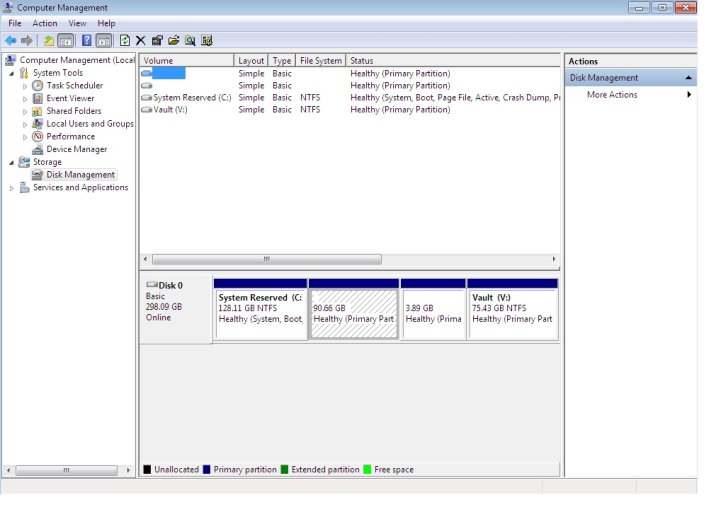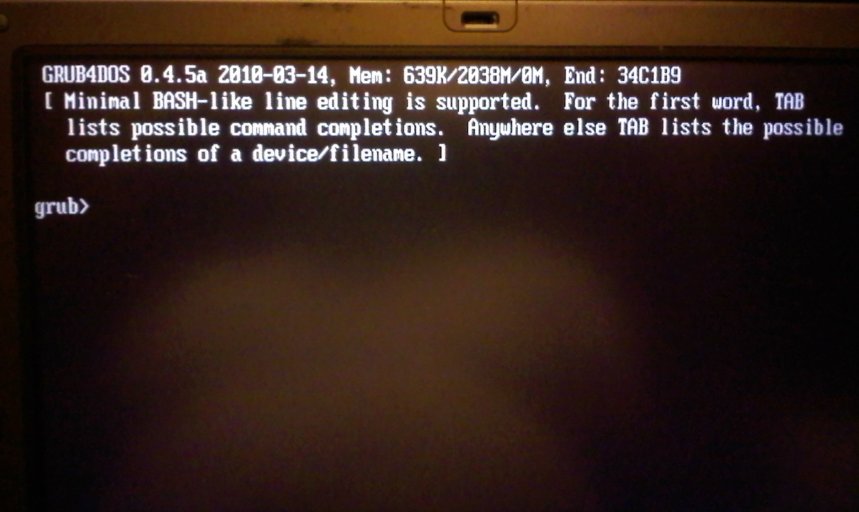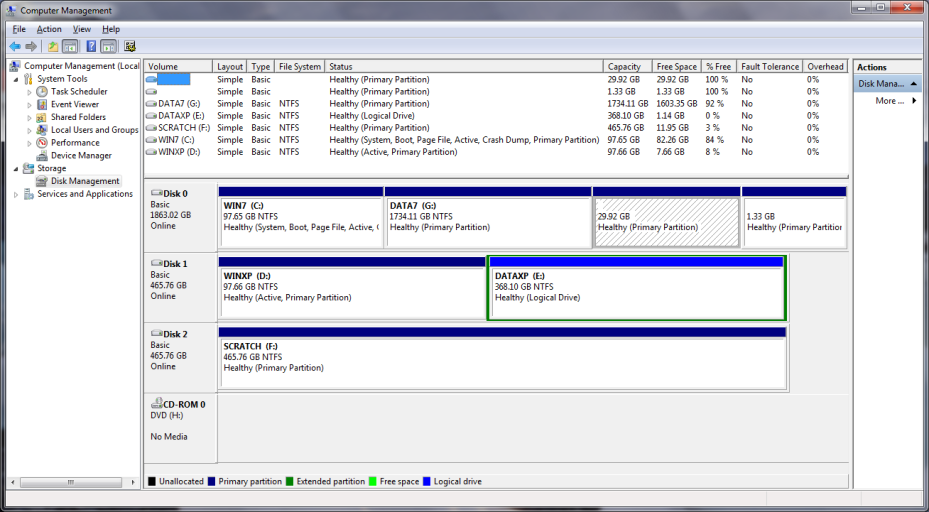3) I went to Advanced (in Summary screen) and changed the location of the loader from dev/sda to dev/sdb5. The check-box "Install loader" was checked.
During the install, there were messages about preparing grub2 for dev/sdb5
4) After Kubuntu was installed, I booted into Win 7, started EasyBCD 2 (build 100) and added Kubuntu, with grub2 option.
If I select Kubuntu in the boot menu, the following things appear on the screen (had to use a video camera to catch the first commands):
1) Try (hd0,0) : NTFS5:
2) Get lower
3) Starting cmain()
4) and finally the grub4dos prompt
I issued geometry command at the prompt, but grub4dos recognized only the ntfs partitions.
With root (hdx,y) command, it again could mount all ntfs partitions, but could not mount the linux ones.
Here is EasyBCD info:
Code:
Windows Boot Manager
--------------------
identifier {9dea862c-5cdd-4e70-acc1-f32b344d4795}
device boot
description Windows Boot Manager
locale en-US
inherit {7ea2e1ac-2e61-4728-aaa3-896d9d0a9f0e}
default {9d20d553-75ec-11df-aa22-0019dbb1d8bf}
resumeobject {a002ac18-2cbd-11df-88ac-b7d015f3b7dd}
displayorder {a002ac19-2cbd-11df-88ac-b7d015f3b7dd}
{9d20d553-75ec-11df-aa22-0019dbb1d8bf}
{9d20d555-75ec-11df-aa22-0019dbb1d8bf}
toolsdisplayorder {b2721d73-1db4-4c62-bf78-c548a880142d}
timeout 10
displaybootmenu Yes
Windows Boot Loader
-------------------
identifier {a002ac19-2cbd-11df-88ac-b7d015f3b7dd}
device partition=C:
path \Windows\system32\winload.exe
description Windows 7
locale en-US
inherit {6efb52bf-1766-41db-a6b3-0ee5eff72bd7}
recoverysequence {a002ac1a-2cbd-11df-88ac-b7d015f3b7dd}
recoveryenabled Yes
osdevice partition=C:
systemroot \Windows
resumeobject {a002ac18-2cbd-11df-88ac-b7d015f3b7dd}
nx OptIn
Real-mode Boot Sector
---------------------
identifier {9d20d553-75ec-11df-aa22-0019dbb1d8bf}
device boot
path \NTLDR
description Windows XP
Real-mode Boot Sector
---------------------
identifier {9d20d555-75ec-11df-aa22-0019dbb1d8bf}
device partition=C:
path \NST\AutoNeoGrub0.mbr
description Kubuntu Linux
I copied the grub.cfg from the installed Kubuntu (using the live cd):
Code:
#
# DO NOT EDIT THIS FILE
#
# It is automatically generated by /usr/sbin/grub-mkconfig using templates
# from /etc/grub.d and settings from /etc/default/grub
#
### BEGIN /etc/grub.d/00_header ###
if [ -s $prefix/grubenv ]; then
load_env
fi
set default="0"
if [ ${prev_saved_entry} ]; then
set saved_entry=${prev_saved_entry}
save_env saved_entry
set prev_saved_entry=
save_env prev_saved_entry
set boot_once=true
fi
function savedefault {
if [ -z ${boot_once} ]; then
saved_entry=${chosen}
save_env saved_entry
fi
}
function recordfail {
set recordfail=1
if [ -n ${have_grubenv} ]; then if [ -z ${boot_once} ]; then save_env recordfail; fi; fi
}
insmod ext2
[B]set root='(hd1,5)'[/B]
search --no-floppy --fs-uuid --set 9df03469-8270-44ec-9d78-0499a724b5a5
if loadfont /usr/share/grub/unicode.pf2 ; then
set gfxmode=640x480
insmod gfxterm
insmod vbe
if terminal_output gfxterm ; then true ; else
# For backward compatibility with versions of terminal.mod that don't
# understand terminal_output
terminal gfxterm
fi
fi
insmod ext2
[B]set root='(hd1,5)'[/B]
search --no-floppy --fs-uuid --set 9df03469-8270-44ec-9d78-0499a724b5a5
set locale_dir=($root)/boot/grub/locale
set lang=en
insmod gettext
if [ ${recordfail} = 1 ]; then
set timeout=-1
else
set timeout=10
fi
### END /etc/grub.d/00_header ###
### BEGIN /etc/grub.d/05_debian_theme ###
set menu_color_normal=white/black
set menu_color_highlight=black/light-gray
### END /etc/grub.d/05_debian_theme ###
### BEGIN /etc/grub.d/10_linux ###
menuentry 'Ubuntu, with Linux 2.6.32-21-generic' --class ubuntu --class gnu-linux --class gnu --class os {
recordfail
insmod ext2
[B]set root='(hd1,5)'[/B]
search --no-floppy --fs-uuid --set 9df03469-8270-44ec-9d78-0499a724b5a5
linux /boot/vmlinuz-2.6.32-21-generic root=UUID=9df03469-8270-44ec-9d78-0499a724b5a5 ro quiet splash
initrd /boot/initrd.img-2.6.32-21-generic
}
menuentry 'Ubuntu, with Linux 2.6.32-21-generic (recovery mode)' --class ubuntu --class gnu-linux --class gnu --class os {
recordfail
insmod ext2
[B]set root='(hd1,5)'[/B]
search --no-floppy --fs-uuid --set 9df03469-8270-44ec-9d78-0499a724b5a5
echo 'Loading Linux 2.6.32-21-generic ...'
linux /boot/vmlinuz-2.6.32-21-generic root=UUID=9df03469-8270-44ec-9d78-0499a724b5a5 ro single
echo 'Loading initial ramdisk ...'
initrd /boot/initrd.img-2.6.32-21-generic
}
### END /etc/grub.d/10_linux ###
### BEGIN /etc/grub.d/20_memtest86+ ###
menuentry "Memory test (memtest86+)" {
insmod ext2
[B]set root='(hd1,5)'[/B]
search --no-floppy --fs-uuid --set 9df03469-8270-44ec-9d78-0499a724b5a5
linux16 /boot/memtest86+.bin
}
menuentry "Memory test (memtest86+, serial console 115200)" {
insmod ext2
[B]set root='(hd1,5)'[/B]
search --no-floppy --fs-uuid --set 9df03469-8270-44ec-9d78-0499a724b5a5
linux16 /boot/memtest86+.bin console=ttyS0,115200n8
}
### END /etc/grub.d/20_memtest86+ ###
[/code[
[/quote]See all the [B]bold[/B]ed lines above? Change all the 1s to 0s instead, and Kubuntu should now boot. Since you installed Kubuntu on the second HDD according to the BIOS, then after the install, changed the boot sequence, and made W7's HDD as first, Grub2 is no longer looking in the right places.
[quote]
[code]
### BEGIN /etc/grub.d/30_os-prober ###
[B]menuentry "Microsoft Windows XP Professional (on /dev/sda1)" {
insmod ntfs
[/B][B]set root='(hd0,1)'
search --no-floppy --fs-uuid --set 44ec66a9ec6694c8
drivemap -s (hd0) ${root}
chainloader +1
}[/B]
[/quote]Replace the bolded entry with this:
[code]menuentry "Microsoft Windows XP Professional (on /dev/sdb1)" {
drivemap (hd0) (hd1)
drivemap (hd1) (hd0)
set root=(hd0)
chainloader (hd1,1)+1
Code:
menuentry "Windows 7 (loader) (on /dev/sdb1)" {
insmod ntfs
[B]set root='(hd1,1)'[/B]
search --no-floppy --fs-uuid --set 32902d3d902d08c5
chainloader +1
}
### END /etc/grub.d/30_os-prober ###
### BEGIN /etc/grub.d/40_custom ###
# This file provides an easy way to add custom menu entries. Simply type the
# menu entries you want to add after this comment. Be careful not to change
# the 'exec tail' line above.
### END /etc/grub.d/40_custom ###
And finally, the Disk management screenshot is attached.
I'm very willing to diagnose the problem as much as needed, thanks in advance!
Change the final
bolded line to (hd
0,1), and you should be all set, and you'll be able to boot all systems with the Ubuntu HDD as first in the boot sequence if you have to, as well as boot all systems now with your current setup booting from the W7 HDD.
Cheers.
Addendum:
OK, I've installed the latest build of EasyBCD 2.0, selected the Grub2 option and I still get the same thing: a grub> command prompt when I select Ubuntu from the boot menu.
Here is a copy of my EasyBCD settings in Debug mode:
Windows Boot Manager
--------------------
identifier {9dea862c-5cdd-4e70-acc1-f32b344d4795}
device partition=C:
description Windows Boot Manager
locale en-US
inherit {7ea2e1ac-2e61-4728-aaa3-896d9d0a9f0e}
default {f80ce627-367c-11df-ae38-b87f10f6c533}
resumeobject {f80ce626-367c-11df-ae38-b87f10f6c533}
displayorder {f80ce627-367c-11df-ae38-b87f10f6c533}
{f80ce650-367c-11df-ae38-b87f10f6c533}
toolsdisplayorder {b2721d73-1db4-4c62-bf78-c548a880142d}
timeout 30
displaybootmenu Yes
Windows Boot Loader
-------------------
identifier {f80ce627-367c-11df-ae38-b87f10f6c533}
device partition=C:
path \Windows\system32\winload.exe
description Windows 7
locale en-US
inherit {6efb52bf-1766-41db-a6b3-0ee5eff72bd7}
recoverysequence {f80ce628-367c-11df-ae38-b87f10f6c533}
recoveryenabled Yes
osdevice partition=C:
systemroot \Windows
resumeobject {f80ce626-367c-11df-ae38-b87f10f6c533}
nx OptIn
Real-mode Boot Sector
---------------------
identifier {f80ce650-367c-11df-ae38-b87f10f6c533}
device partition=C:
path \NST\AutoNeoGrub0.mbr
description NeoSmart Linux
Also, a screenshot of Disk Management and the Grub> prompt that I get when I attempt to boot Ubuntu:
Ok, all of that looks good.
Post the contents of your /boot/grub/grub.cfg on your Ubuntu partition, and we'll take a look at that too.



